Ultimate Home Gym Flooring Guide
Author:
Reviewed by:
(Head of Sport Science, 20 years of Oly Lifting experience, PhD Sport Science)
Unlock your full potential by engaging with our experts and community! Have questions about your fitness journey or looking for expert advice on weightlifting techniques? Don’t hesitate — leave a comment below and Jacek Szymanowski will provide a personalized answer and insights to help you reach your goals.
Torokhtiy is reader-supported. Some links are affiliate links, and we may earn a commission at no extra cost to you. See our disclosure page for details.
Assuming you are planning to open a home gym, you must have already researched equipment and stuff. But what about the flooring? The flooring is the base of your gym and will influence its durability, cleanliness, aesthetics, and even noise. So, selecting quality home gym flooring is a priority.
And if you haven’t given a thought to this part, don’t worry; we got you covered with a bunch of information on how to pick your flooring, what to look out for, and we even have a recommendation for you. Have a look.
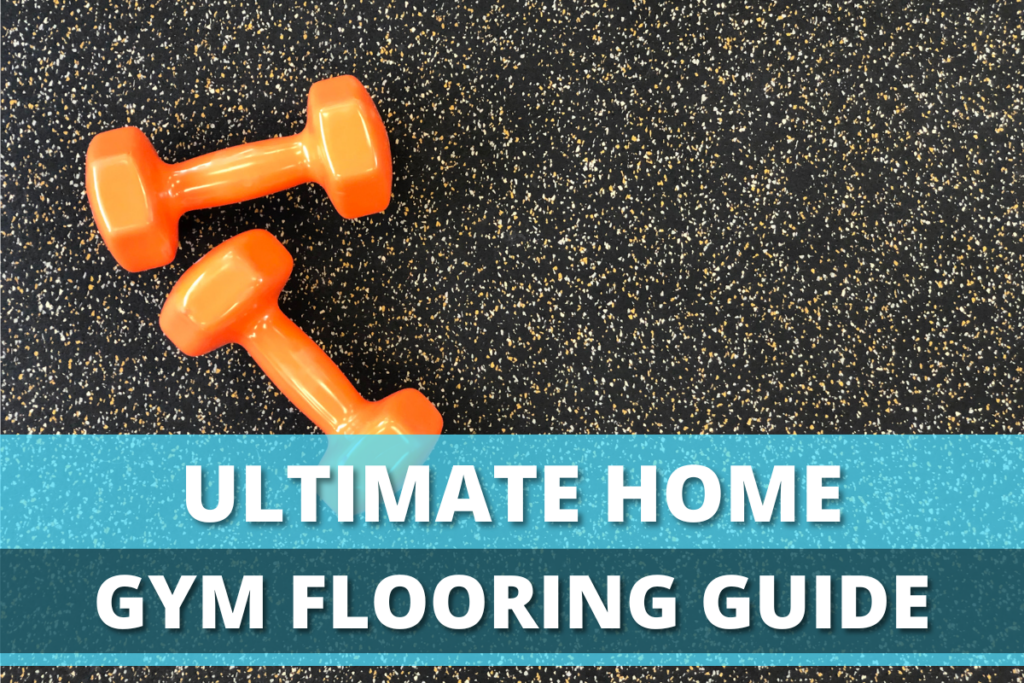
What Is Home Gym Flooring?
During a gym session, people will use and drop weights that can damage your standard flooring. The same is also possible due to the weight of large gym machines.
And since it’s costly to replace the whole floor with something like wood or cork, it’s essential to use home gym flooring. It forms a layer over your usual floor, adding to damage resistance and shock absorption. Its the reason why the market for gym flooring is increasing along with the number of flooring options.
The floorings are available in many different designs, materials, and sizes. But for home gyms, it’s best to stick with the following options.
6 Benefits of Having Home Gym Flooring
Getting the best gym flooring is a great help in enhancing the aesthetics of your place. It can make the place look clean and also influence its hygiene. They are developed to prevent issues like mold and bacteria.
Moreover, the gym floors are high in impact strength. They can absorb most of the shock, preventing any damage to your main floor. Not to mention, reduce the noise of falling equipment and weights.
Good quality gym floor mats can also prevent gym injuries by providing a softer landing surface and better grip you need for your workout. They also form a very even and somewhat non-shifting surface, reducing the risk of stumbling.
Regardless of whether you already own gym flooring, or are just planning to buy, it doesn’t hurt to know all the benefits of using them.
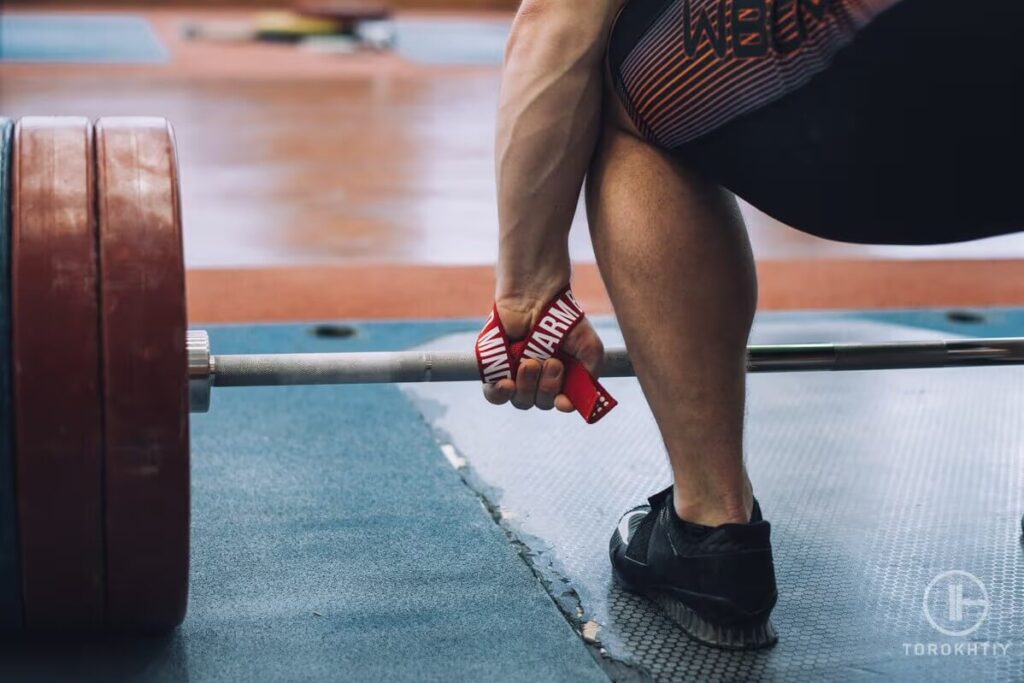
✅ Floor Protection
The most obvious benefit – it protects your floors. Heavy gym equipment can do a decent amount of damage if you don’t use some kind of floor protection.
When thinking of ‘floor protection’, heavy lifting often comes to mind, but that is not the only issue. Static equipment (e.g., exercise bikes) can leave scuffs, imprints, and even scratches on the floor if the floor is unprotected.
✅ Equipment Stability
Gym flooring is cushioned, which means it will make your workout equipment more stable. It will reduce movement and vibrations so your machines and accessories stay in place.
✅ Absorbing Shock
If you get high-quality flooring, then you’ll notice how well it can absorb shock. This comes in handy with jumping or running, and it’s also good for your joints. Also, it’s important to note that shock-absorbing flooring can prevent falls.
✅ Less Noise
Workouts can be loud, but gym flooring will absorb a lot of the noise and make the environment more quiet. Imagine dropping weights on the floor and the noise that would produce. With a good surface, however, you don’t have to worry about that.
✅ Comfort
Have you ever tried working out on hardwood floors? If you haven’t, do yourself a favor and don’t try. It’s extremely uncomfortable, which is why you need the cushioning that gym flooring can provide.
✅ Hygiene
Gym flooring is easy to clean and maintain. You just wipe it down, and all the sweat, dust, and grime goes away. This makes your gym more pleasant, and hygienic, and there’s less bacteria and odor.
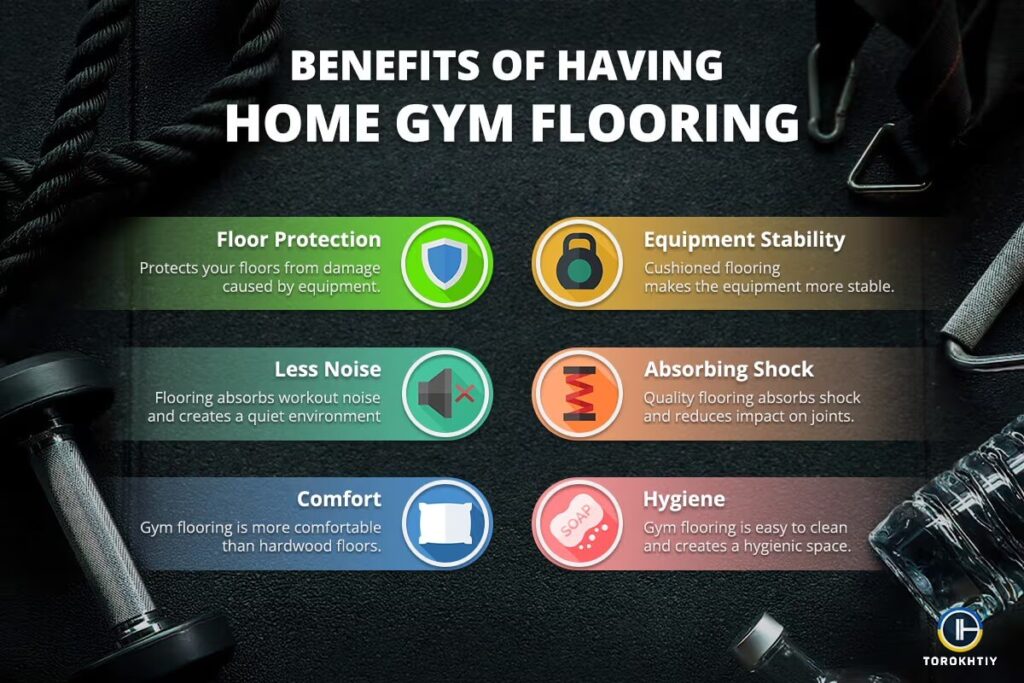
7 Main Types for Home Gym Flooring
1. Rubber
Rubber flooring is the most preferred option for home gyms due to its ease of use and cost. It’s the cheapest gym flooring option that’s also ready to use without any expert installation.
Just measure your place, cut the sheets according to it, and lay them out. You can use carpet tapers or other fixtures, but the flooring type can work perfectly even without them. As for size, it’s available in multiple sizes and both as rolls and as tiles.
Another big advantage is that rubber is easy to clean. Plus, rubber is pretty durable, shock absorbent, and it’s high on grip. The rubber flooring is perfect for activities like weight lifting that need high stability and traction. So, dropping weight isn’t a problem. Although, this flooring can have that rubbery odor.
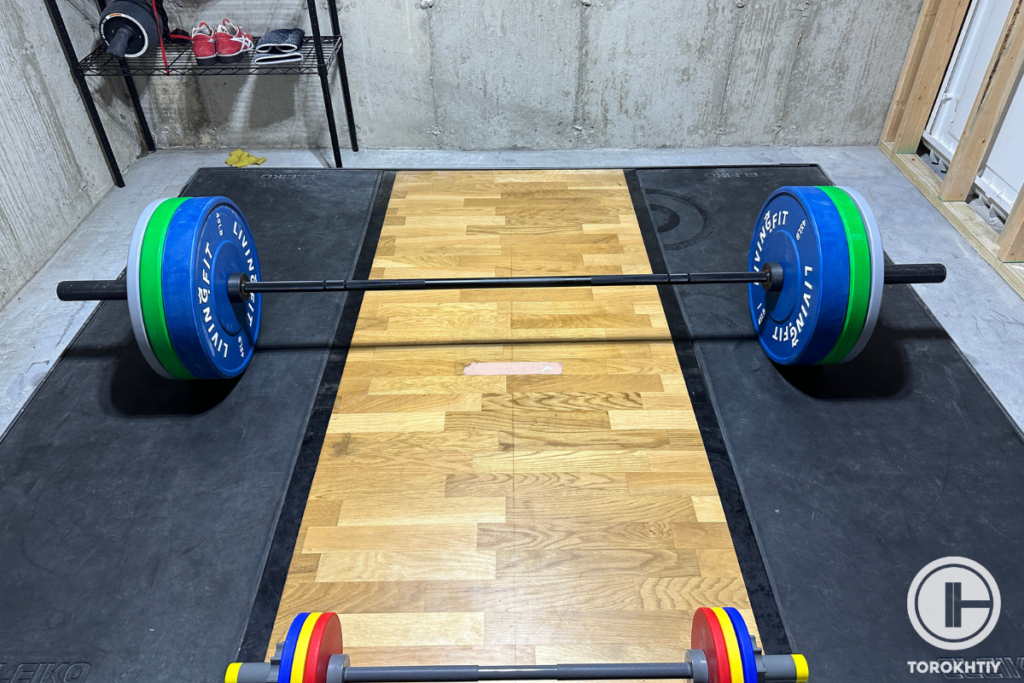
2. Stall Mats
Being honest, stall mats are a subtype of rubber mats. It’s like a thicker version of rubber flooring that’s designed for farms. They are used for horses, so you can expect very high durability and damage resistance. And it doesn’t need much cleaning.
The flooring usually comes in tile shape, and you can cut or add tiles to fit your needs. However, you will need some sort of fixture, like carpet tape, to create clean seams. And as it’s made from recycled tires, the odor is rather strong. It does reduce with time, though.
3. Foam
Foam-based gym floor mats are the best alternative to rubber. It has identical features and offers somewhat the same life and ease of installation.
The difference is that this flooring comes in standard-size tile and will have some sort of pattern to interlock them. Like rubber, you can cut the foam pieces to adjust the size. Most companies will also provide specific pieces that interlock with the end tiles.
The only problem with foam gym flooring is that it compresses. If you keep a machine or heavyweight in the same place for a long time, it will form a permanent compression. Moreover, this compression makes the flooring unsuitable for weight lifting. And being soft, the foam flooring is easy to cut and can take heat damage.
4. Carpet
Turf carpets are yet another great material for your home gym. The material, as you can guess from its name, depicts a particular terrain, usually a grass field, over a layer of foam. You may have seen them being used for football grounds. Although, the turf carpets used for the home gym are softer.
The flooring is great for activities like lunges, warming up, short-distance sled works, hip thrusts, and more. However, it’s not ideal for heavy workouts. In other words, it’s not a standalone type and is mostly used in combination with rubber or foam mats.
5. Vinyl
If you intend to use the gym for light workouts and Yoga, Vinyl can be an option. The material offers a long life of 5-10 years and is the best flooring for a workout room in terms of aesthetics. Vinyl is also water and mold-resistant. Plus, it’s very easy to clean it.
But again, you cannot use it for weight training as it has zero noise reduction and shock absorption. Your floor will bear the full impact of any drop. Plus, it’s very thin, so you need to combine it with yoga mats or underline. Thus, it’s the last resort.
6. Plastic
This usually comes in the form of interlocking tiles, it’s lightweight and easy to put together. Plastic flooring is also very affordable and comfortable. It’s not as durable as rubber flooring, but can still offer decent protection for your floors and equipment.
7. Turf
Artificial turf is the most unique type of flooring you can get, and it’s also very visually appealing. It’s used in functional training areas, sled pushes, and agility exercises. The turf is cushioned and grippy, so it’s great for many different types of workouts. When it comes to maintenance, regular brushing is required.
This way you’re keeping the fibers upright. Also, do an occasional wash to remove accumulated dirt and sweat. With proper care and the turf’s durability, it will remain in good condition for a long time.
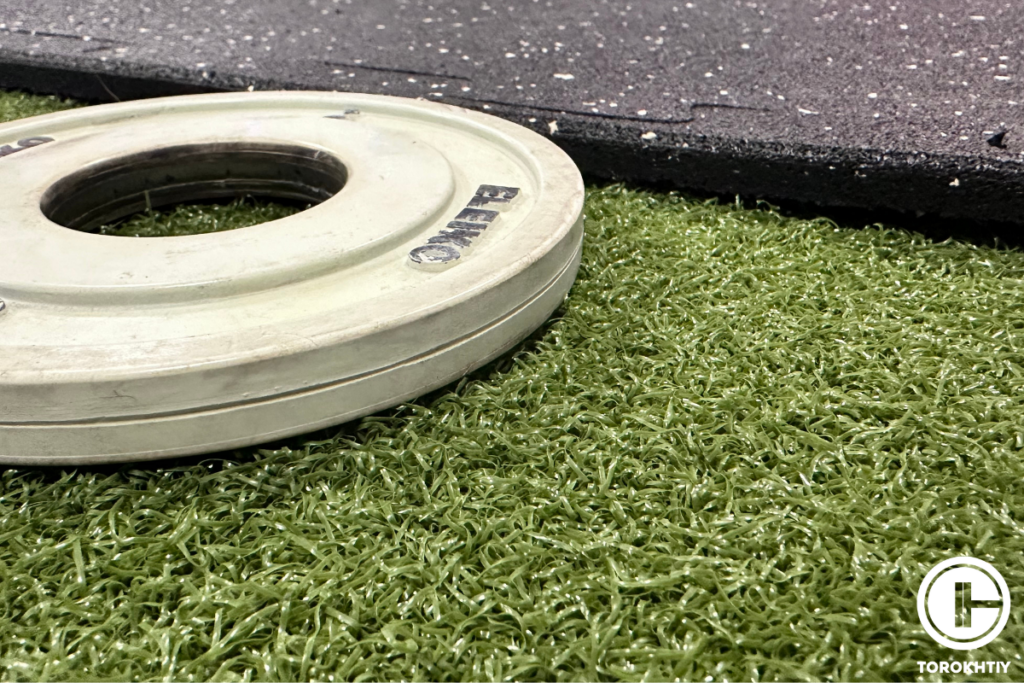
What to Look For in Home Gym Flooring?
Flooring is a big deal, so you want to make sure you’re getting something that will suit your needs – and this means it should be comfortable for you, and it should protect your floors and equipment. There are a few very important things to pay attention to before you decide on what to add to your home gym.
How to Choose Proper Flooring?
| Criteria | Weightlifting | Yoga & Bodyweight Exercises (calisthenics) | Aerobics & Cardio | Mixed Workouts |
|---|---|---|---|---|
| Ease of Assembly | Interlocking tiles (quick assembly/disassembly) | Mats (easy to roll and store) | Interlocking tiles (quick assembly/disassembly) | Interlocking tiles or mats (setting up versatility) |
| Protection | Dense Rubber (protects floor and joints) | Foam (protects joints) | Vinyl (easy cleaning, protects floor) | Rubber or foam (protects floor and joints) |
| Durability | High (wear resistance) | Medium (wear resistance) | Medium to high (wear resistance) | High (wear resistance) |
| Price/Quality | Choose long-term benefits over initial cost (if possible) | Balance comfort and cost | Choose ease of cleaning and durability over the initial cost | Consider versatility and long-term benefits over cost |
| Thickness | Preferably ½–¾ inch (added shock absorption) | At least ¼ inch (comfort) | ¼–½ inch (shock absorption) | ½ inch (balanced for varied exercises) |
| Material | High-quality rubber (product longevity) | High-quality foam or carpet (product longevity) | High-quality vinyl or foam (product longevity) | High-quality rubber or foam (product longevity) |
| Compression | Low (stability) | Medium to High (cushion and comfort) | Medium (joint protection) | Medium (balance between lifting and body exercises) |
| Grip | High (more friction – less slippage, prevent accidents) | High (more friction – less slippage, prevent accidents) | High (more friction – less slippage during fast-paced movement) | High (higher grip – more safety) |
| Noise Reduction | Foam or rubber (minimize noise from dropping weights) | Not an important factor | Foam (reduce noise from steps/jumps) | Rubber or Foam (general noise reduction) |
1. Ease of Assembly
The easier and more straightforward the gym flooring is to assemble, the better (especially if you have a home gym setup where you have to assemble/disassemble on a daily basis).
Look for flooring options that have clear-cut instructions and ensure they don’t require any additional or specialized tools. Mats and interlocking tiles are commonly user-friendly.
2. Protection
Floor protection is there to protect the floor, and the athlete (think of joint friendliness). Think of the types of exercises that will be performed and choose accordingly.
3. Material
The quality of the materials affects all of the listed criteria in some way. When buying floor tiles, your primary criteria should be product longevity. High-quality materials will resist wear and tear better, helping it to retain its good condition for longer.
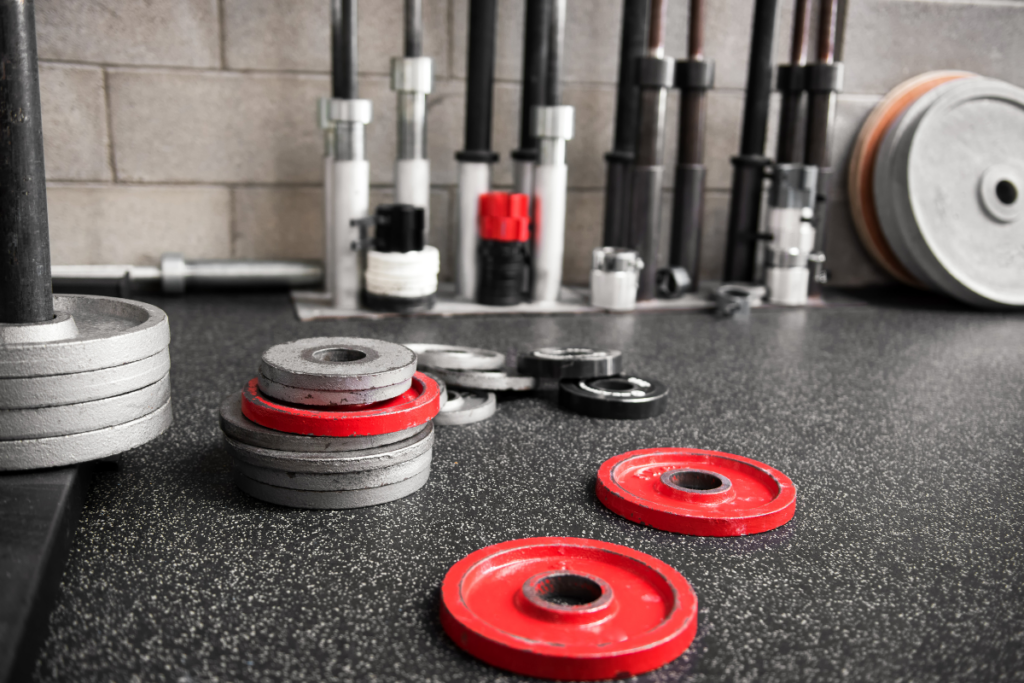
4. Durability
If you’re going to do heavy weightlifting, using heavy gym equipment /machinery (e.g., treadmills, rowers, exercise bikes, etc.), or moving equipment around the gym regularly, then you’ll benefit greatly from getting flooring that will be able to withstand the rough treatment without showing signs of wear.
5. Price/Quality
Think of your budget and how much flooring you need. It might be tempting to buy cheaper options, but it is vital to weigh the price that you’ll be paying with the benefits you’ll enjoy (or not enjoy). Sometimes investing more upfront can save you more money in the long run – while providing you with greater benefits.
6. Thickness
This will affect comfort and shock absorption. Thick flooring (like rubber and foam) is going to absorb shocks and make the workouts easier on your body, but especially the joints.
If you’re unsure what good thickness is, keep in mind that standard gym flooring varies in thickness from ¼ inch to ¾ inch (you can even find some specialized going to 1 inch in thickness).
Choose the thickness of the flooring depending on the exercise/workout you plan on performing. For heavy weightlifting, a thicker mat is often better. For basic training and basic body exercises, ¼ of an inch can suffice.
7. Type of Exercise
Flooring needs to match the workouts you do, so don’t skip this step. If you do a lot of heavy lifting and weight training, choose something durable, like dense rubber. If you like yoga and bodyweight exercises, then your best bet is something comfortable and cushioned, like foam or carpet.
Tips From the Champ
When selecting gym flooring, consider the thickness based on your workout routine. For heavy weightlifting and intense exercises, opt for thicker mats like rubber or foam to provide better shock absorption and joint protection. However, for basic training and simpler exercises, a 1/4-inch thick mat may suffice.
Olympic Weightlifting Champion
8. Noise Reduction Abilities
Rubber and foam are the absolute best when it comes to reducing the amount of noise. If your workouts include dropping weights or high-impact movements, then foam or rubber flooring is ideal.
9. Grip
Good grip will prevent accidents that can lead to injuries. Rubber, vinyl, and certain kinds of foam are very grippy, so you have less to worry about slips or falls with them.
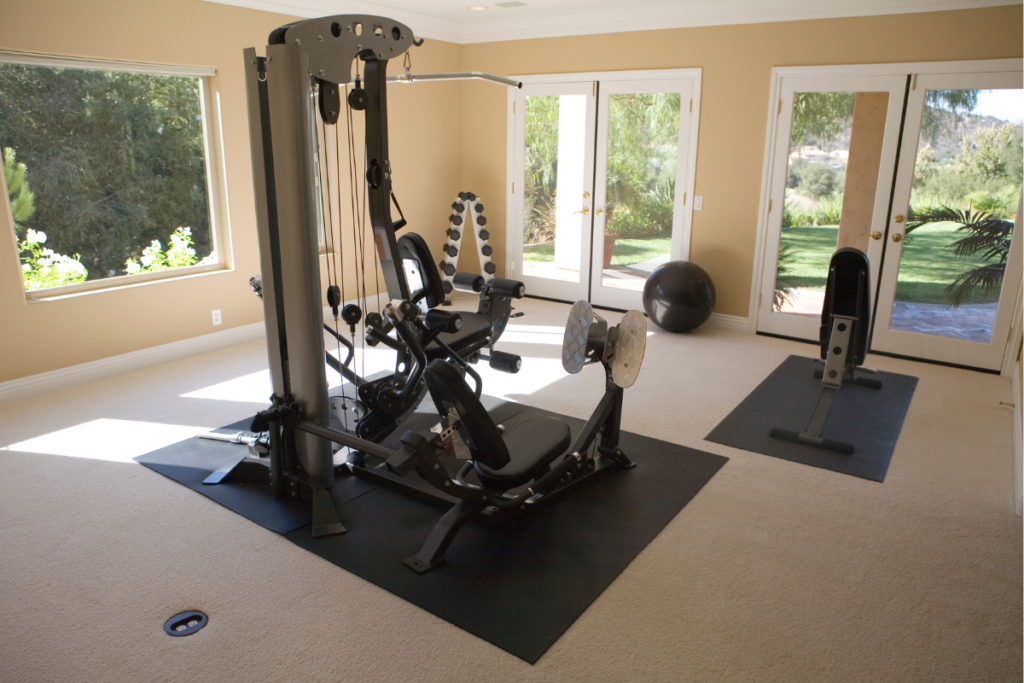
10. Compression
Compression refers to how much the flooring gives under pressure and how well it bounces back. You want minimal compression for heavy lifting and equipment because your priority is stability. Rubber and vinyl are known for low compression, so they’re ideal for weightlifting.
11. Color and Design
Color and design have a huge impact on how your gym looks, so choose something that won’t annoy you if you’re looking at it on a daily basis. Keep the theme of your gym in mind, but also consider the fact that lighter colors show dirt and wear more quickly than darker ones.
American Floor Mats Interlocking Rubber Tiles
American Floor Mats made some exceptional and easy-to-install gym flooring. If you’re looking for something to protect your floors, you can’t go wrong with these tiles.
They’re made to absorb any shock and pressure, so you can put whatever kind of weights or equipment on them without worrying about damage – to either the equipment or the floors.
The 0.38” thickness is a perfect balance of stability and cushioning. The surface is stable enough for all types of workouts and will remain durable. Each tile is 2”x2” and covers 4 square feet – more than enough coverage for home gyms.
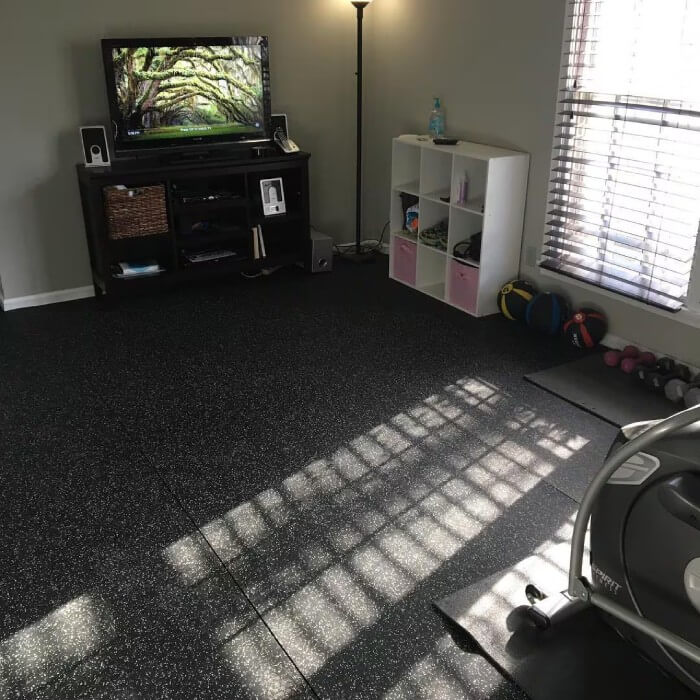
What stands out with these tiles is how seamless they are once you place them. There’s no need for glue because they’re interlocking, and you can also reposition them easily.
The tiles will comfortably cover any type of area because they come as center, border and corner tiles.
5 Tips on How to Install Home Gym Flooring
Installing the flooring correctly can be a very simple thing to do, if you make sure you know what you’re doing first. It’s also crucial when it comes to the flooring’s functionality and longevity.
| Step | Description |
|---|---|
| Space Preparation | Clean and clear the area and make sure it’s leveled. |
| Measuring | Measure your workout area. |
| Start from the Center | Start at the center and work your way out. |
| Proper Alignment | If you’re using interlocking tiles, make sure all the connectors are aligned. |
| Adjusting | Regularly check everything is aligned and leveled and make adjustments if necessary. |
1. Space Preparation
The first step is to clear the area your new flooring is going to be installed in. Clean it thoroughly and remove furniture or anything else that may get in the way.
2. Measuring
Once everything is cleared out, it’s time to measure the space so you know how much flooring you need. Keep in mind, there may be some cuts or adjustments done to the flooring.
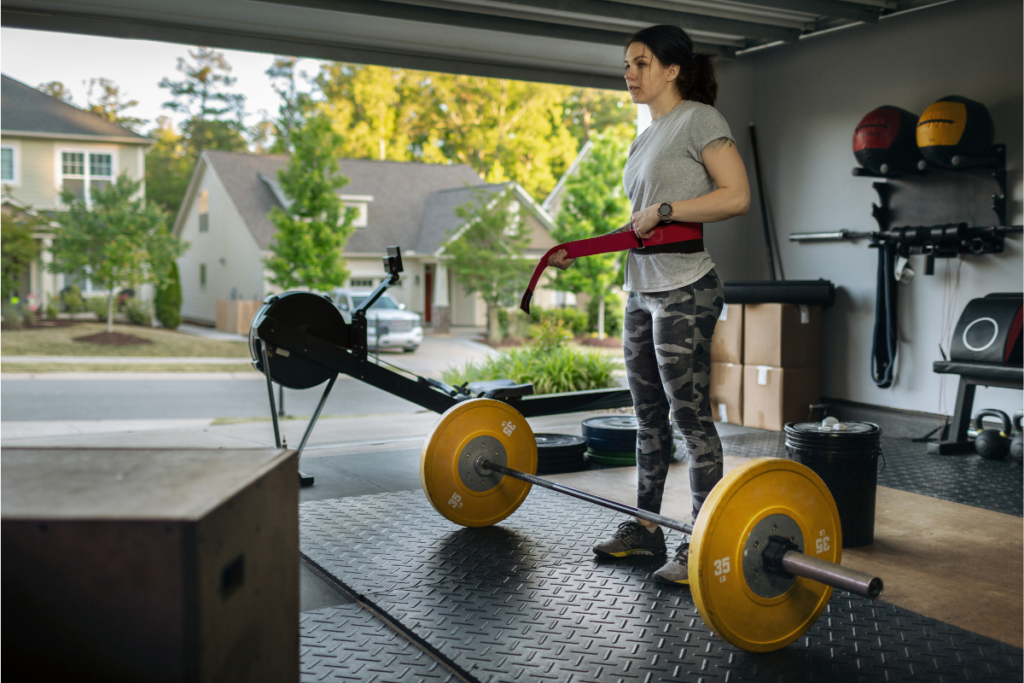
3. Start from the Center
Start at the center and work your way out. If you need to make some cuts to make the flooring fit against the walls, they’ll be less noticeable because there will be no cuts in the center.
4. Proper Alignment
If you’re using interlocking tiles, make sure the connectors are properly aligned. If the connectors are not aligned, there can be gaps, and the final result may be uneven.
5. Adjusting
As you go along, check that everything is leveled and aligned and make sure there are no gaps. If you need to, you can make adjustments.
How to Clean Home Gym Matting in 6 Steps?
1. Sweeping and Vacuuming
Make sure you’re regularly removing dust and dirt that builds up. This makes sure your surface keeps its nice appearance for a long time.
2. Cleaning Spills and Stains
As soon as you see a stain or spill on the flooring, wipe it down with a damp cloth and some mild soap. If you let the stain sit, it will set, and you’ll have a very hard time removing it.
3. Deep Cleaning
Gyms, in general, can be filled with all sorts of bacteria(even ones resistant to antibiotics!), so your flooring needs to be deep-cleaned every once in a while, so set up a routine. If there are no instructions from the manufacturer, a deep clean every few weeks is ideal.
4. Use Mild Cleaning Products
Harsh chemicals can damage the flooring, so use something mild and gentle. You can also find cleaning solutions designed especially for mat cleaning.
5. Avoid Too Much Moisture
Don’t soak the mat. Instead, use a damp cloth, because too much moisture can lead to mold, mildew, and odor.
6. Air Drying
Anything other than air drying at room temperature is a big no-no. Also, direct sunlight can cause damage just like heat can.
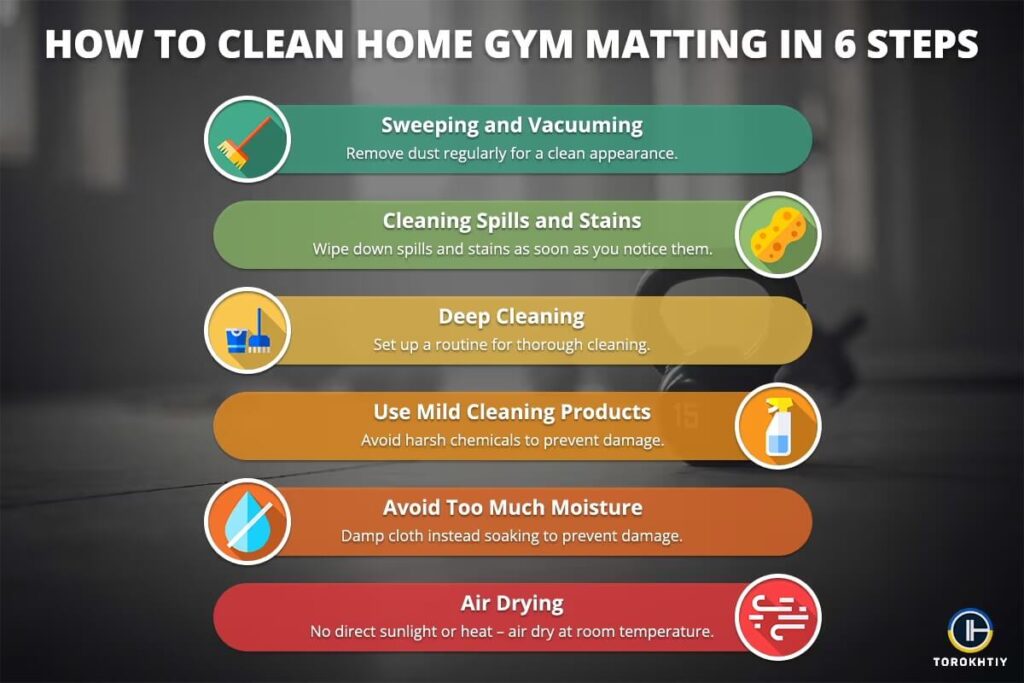
FAQ
What’s the Best Thickness for Home Gym Flooring?
The thickness of your home gym flooring mats will depend on your main flooring material. If it is something hard like concrete, a quarter-inch thick flooring is good, whereas, for softer material, you will need a thickness of half an inch or more.
Do You Need Gym Flooring for Your Home Gym?
The gym floorings are not just for aesthetics. They are essential for hygiene, damage prevention, noise dampening, and for extra grip. So, yes, it’s good to have it.
Do You Need to Put Anything Under the Gym Flooring?
Most of the best mats for home gym don’t need any lining. They may need some tape or glue to hold them in place, but that is all you will need, except vinyl flooring. This flooring is not good for noise prevention, so you might want to add a carpet or foam for that purpose.
Can I Put the Gym Floor Over the Carpet?
Yes, you can use the floor over the carpet, but it’s risky. There’s a chance that the carpet underneath can slip, causing shifts in the floor, which may injure someone. So, if possible, don’t do it.
Conclusion
Finding quality home gym flooring may need some research, but with the information from this article, you know the most important factors to consider. If you are looking for long-term flooring at an affordable rate, just go for the American Floor Mats Interlocking Rubber Tiles.
And don’t forget to share your experience using these home gym floor mats in the comment section below. Also, let us know any flooring you recommend!
Also read:
References:
- “Global Gym Flooring Market by Type” Data Intelo: https://dataintelo.com/report/gym-flooring-market/ (accessed May 10, 2023).
- Dawn C. Mackey “The Flooring for Injury Prevention (FLIP) Study of compliant flooring for the prevention of fall-related injuries in long-term care: A randomized trial” PLoS Med. 2019 Jun 24
- Bethany Keenan “A comparison of floor surfaces for injury prevention in care settings: impact forces and horizontal pulling force required to move wheeled equipment” Osteoporosis International July 2020
- Nabanita Mukherjee “Diversity of Bacterial Communities of Fitness Center Surfaces in a U.S. Metropolitan Area” Int J Environ Res Public Health 2014 Dec 3.
- Nsikan Akpan “Your gym mats may be breeding antibiotic-resistant germs” PBS NewsHour Dec 11, 2018
- Ju-Hyeong Park “Mold exposure and respiratory health in damp indoor environments” Front Biosci (Elite Ed). 2011 Jan 1;3(2):757-71
- Photo by KURJANPHOTO, Canva; photo by photology2000, Canva; photo by IngredientsPhoto, Canva; photo by meltonmedia, Canva; photos by Torokhtiy Media Team
Why Trust Us?
With over 20 years in Olympic Weightlifting, our team does its best to provide the audience with ultimate support and meet the needs and requirements of advanced athletes and professional lifters, as well as people who strive to open new opportunities and develop their physical capabilities with us.
All products we select are primarily approved and tested by the Olympic Weightlifting Champion Oleksii Torokhtiy. Under his guidance, our team provides honest and reasonable assessments of the products we review by checking their characteristics, packaging, design, comfort and durability features, and general product rating. We select products from only high-quality and trusted sports brands, thus vouching for their quality.
The product testing process is described in more detail here
Why Trust Us?
With over 20 years in Olympic weightlifting, strength training, nutrition coaching, and general fitness our team does its best to provide the audience with ultimate support and meet the needs and requirements of advanced athletes and professional lifters, as well as people who strive to open new opportunities and develop their physical capabilities with us.
By trusting the recommendations of our certified experts in coaching, nutrition, and sports training programming, as well as scientific consultants, and physiotherapists, we provide you with thorough, well-considered, and scientifically proven content. All the information given in the articles concerning workout programming, separate exercises, and athletic performance, in general, is based on verified data.
The product testing process is described in more detail here.
Author: Jacek Szymanowski
Certified Nutritionist,
M.Sc.Eng. Biotechnology
Performance Architect,
Strength and Conditioning Specialist
With over 30 years of fighting experience, specialization in nutrition coaching for athletes, and expertise in metabolic health and dietary strategies, Jacek offers a comprehensive approach to optimizing your performance and well-being. Backed by a Master of Science degree in Biotechnology, Jacek remains at the forefront of scientific advancements, ensuring that his coaching is always evidence-based and up-to-date.
Reviewed by: Sergii Putsov
Head of Sport Science, PhD
Best Results: Snatch – 165 kg,
C&J – 200 kg
Sergii Putsov, Ph.D., is a former professional weightlifter and National team member, achieving multiple medals in the 94 kg weight category at national competitions. With a Master’s degree in “Olympic & Professional Sport Training” and a Sport Science Ph.D. from the International Olympic Academy, Greece, Sergii now leads as the Head of Sport Science. He specializes in designing training programs, writing insightful blog articles, providing live commentary at international weightlifting events, and conducting educational seminars worldwide alongside Olympic weightlifting expert Oleksiy Torokhtiy.
If you have any questions/suggestions/any other inquiries considering product reviews, you can reach out to us via email – reviews@torokhtiy.com





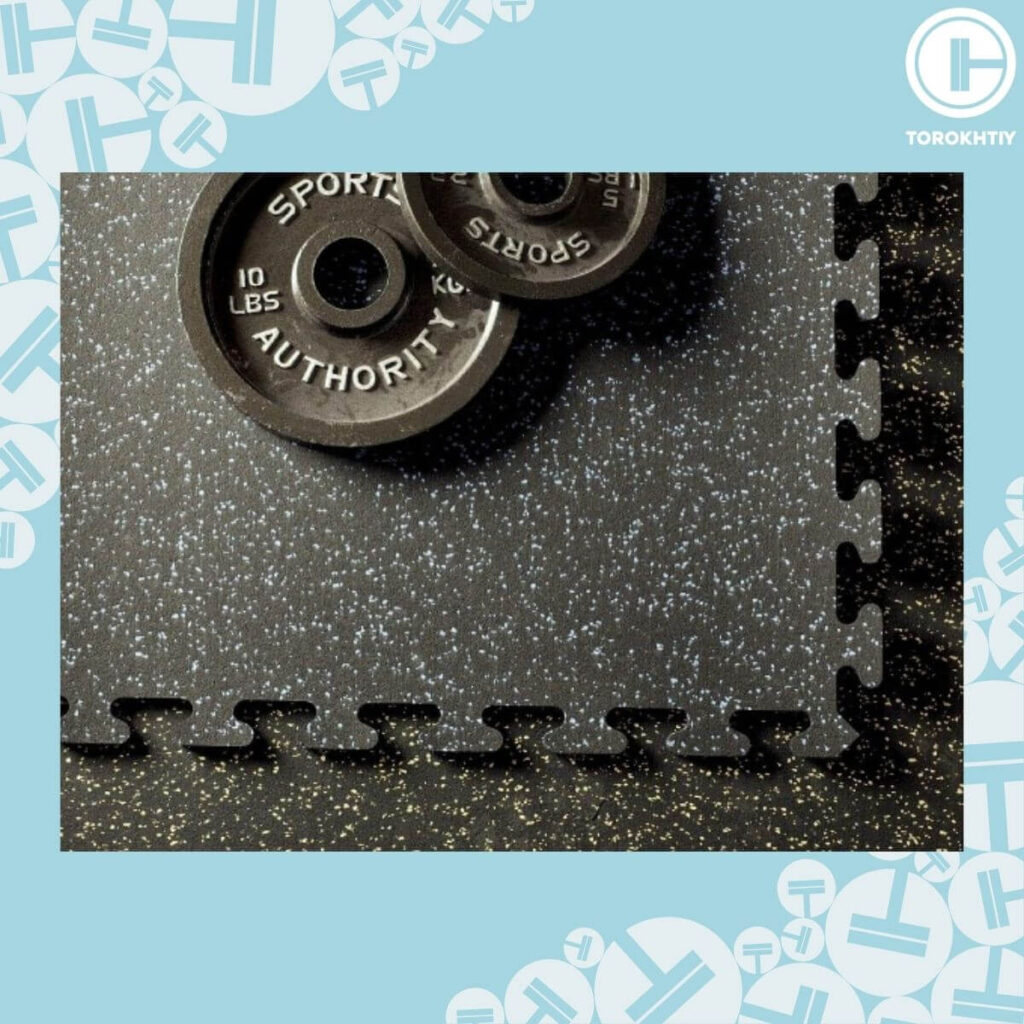
Still have questions after reading our article? Unlock your full potential by engaging with our experts and community! Don’t hesitate — leave a comment below and Jacek Szymanowski will provide a personalized answer and insights to help you reach your goals.